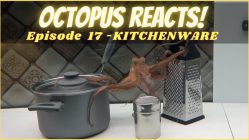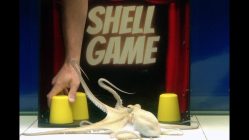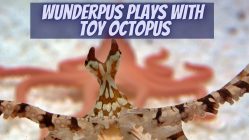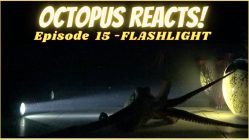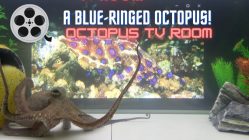The Premise of the Experiment
In this experiment, we were attempting to determine what action an octopus would take in order to gain access to a tasty fish.
A clear plastic container was used. It had latches which allowed us to place a fish inside and lock it.
There was also a smaller opening that was made that was just large enough for the fish to fit.
What would the octopus do?
Assessing the Problem
You will note that the octopus approaches the container knowing that there is something of interest inside. Throughout the process, he is sizing up the situation.
There is a moment in the video when you can tell that the octopus has detected the path of least resistance to obtain his reward. That is the moment that he realizes that there is an opening in the container and he inserts one of his arms inside.
Octopuses Are as Crafty as They Are Malleable
In the wild, octopuses rely frequently on their bodies being malleable and having eight long arms. They use their arms in such a way to reach prey in the wild. Sometimes the prey is hiding in the nooks and crannies between the rocks and coral of the seafloor. Reaching for something with her arms is one of their most frequent and intuitive actions. In other words, if they can find a way to reach something with their arms, why expend mental or physical energy in finding another option?
The Path of Least Resistance
As you continue to watch the video you will observe how this octopus clearly demonstrates his preference to find the path of least resistance. The moment that he determines that the fish can fit through the opening it’s game over. He switches his concentration to aligning the fish so that it can be pulled from the opening.
The octopus transitions from problem solver to an experienced technician in the blink of an eye. Once that is done, it is snack time, baby.
Wait, Do Octopuses Lift Weights?
Towards the end of the video, after the octopus has successfully chowed down his fish, you will notice that he begins to pick up the empty container with his arms. He lifts it without being prompted to do so by the handler.
In all likelihood, the octopus was moving the container to make certain that there wasn’t any more fish inside. Then again, maybe he just wanted the handler to remove that big plastic thing from the tank. Much as when a restaurant patron wants the waiter to remove the dishes from the table when they finish eating.
Does This Mean That Octopuses Cannot Unlock a Plastic Box?
Keep in mind, that one of the signs of intelligence is getting the most out of the least. Since the octopus was able to find an easy solution to get to the fish, he had no reason to find a more complex method to do so.
In future experiments, we will create a situation where the octopus will not have the option of pulling the fish through the opening. That way you will be able to see how an octopus engages in scaled and incremental problem-solving.



